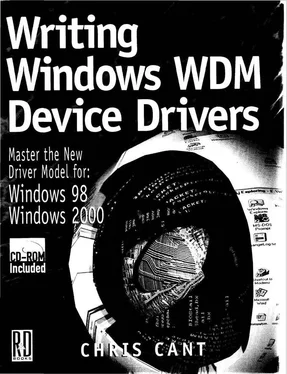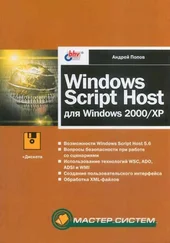Chris Cant - Writing Windows WDM Device Drivers
Здесь есть возможность читать онлайн «Chris Cant - Writing Windows WDM Device Drivers» весь текст электронной книги совершенно бесплатно (целиком полную версию без сокращений). В некоторых случаях можно слушать аудио, скачать через торрент в формате fb2 и присутствует краткое содержание. Город: Lawrence, Kansas 66046, ISBN: , Издательство: R & D Books, Жанр: Программирование, на английском языке. Описание произведения, (предисловие) а так же отзывы посетителей доступны на портале библиотеки ЛибКат.
- Название:Writing Windows WDM Device Drivers
- Автор:
- Издательство:R & D Books
- Жанр:
- Год:неизвестен
- Город:Lawrence, Kansas 66046
- ISBN:0-87930-565-7
- Рейтинг книги:5 / 5. Голосов: 1
-
Избранное:Добавить в избранное
- Отзывы:
-
Ваша оценка:
- 100
- 1
- 2
- 3
- 4
- 5
Writing Windows WDM Device Drivers: краткое содержание, описание и аннотация
Предлагаем к чтению аннотацию, описание, краткое содержание или предисловие (зависит от того, что написал сам автор книги «Writing Windows WDM Device Drivers»). Если вы не нашли необходимую информацию о книге — напишите в комментариях, мы постараемся отыскать её.
Writing Windows WDM Device Drivers — читать онлайн бесплатно полную книгу (весь текст) целиком
Ниже представлен текст книги, разбитый по страницам. Система сохранения места последней прочитанной страницы, позволяет с удобством читать онлайн бесплатно книгу «Writing Windows WDM Device Drivers», без необходимости каждый раз заново искать на чём Вы остановились. Поставьте закладку, и сможете в любой момент перейти на страницу, на которой закончили чтение.
Интервал:
Закладка:
Information on the DDK-L mailing list can be found at http://www.chsw.com/DDK-L/. There is a nominal charge after the first 30 days.
Books
PC 99 System Design Guide, Version 1.0. Microsoft Press, 1998. ISBN 0-7356-0518-1.
Baker, Art. The Windows NT Device Driver Book. Second edition. Prentice Hall, 1999. ISBN 0-13-0204315.
Dekker, Edward N. and Newcomer, Joseph M. Developing Windows NT DeviceDrivers, Vol. 1. Addison Wesley Longman, 1999. ISBN 0-20169590-1.
Hazzah, Karen. Writing Windows VxDs and Device Drivers. Second edition. R&D Books, 1997. ISBN 0-87930-438-3.
Mason, Anthony and Viscarola, Peter G. Windows NT Device Driver Development. Macmillan Technical Publishing, 1998. ISBN 1-57870-0582.
Solomon, David A. Inside Windows NT. Second edition. Microsoft Press, 1998. ISBN 1-57231-677-2.
Appendix B
PC 99
PC 99 is a hardware and software specification for various types of PCs: Consumer PCs, Office PCs, and Entertainment PCs, including mobile PCs. Windows CE portables are not covered.
Certified PC 99 compliance gets you a nice "Designed for Microsoft Windows" logo on your box.
Drivers
Software plays a large part in achieving PC 99 compliance. Having a driver for both Windows 98 and Windows 2000 is a requirement for all PC types. If a driver is bundled with a PC when it is sold, it must pass the PC 99 compliance tests.
The PC 99 specification says that a driver must not use INI files, just the registry. INF style installation must be used, if possible. Drivers must be installed in the correct directories. A driver must not use the same filename as a system driver. A driver must be installable without user input. If a driver has any special parameters, a help file for these must be provided.
WDM drivers must fit in with all the bus specifications and device class driver specs.
The Specification
The PC 99 specification is in the MSDN Library CD Books section. It has many useful appendices and checklists. There are required, recommended, and optional features.
The specification is also available in book form. The PC 99 System Design Guide, version 1.0 is available from Microsoft Press (ISBN 0-7356-0518-1).
The general drift of the specification is to move PCs away from the traditional IBM-compatible PC to one dominated by PCI, SCSI, USB, and IEEE 1394 devices. No ISA slots are now allowed!
For each PC type, it defines what standard devices must be available and what are the possible options. For example, a basic PC (a 300Mhz Pentium with MMX with 32Mb memory) must have hard disk, keyboard, mouse, serial, and parallel ports, V.90 modem, a graphics adapter, and two USB ports. If possible, most external devices should use the USB bus.
Standard PC options include wireless operation, DVD drive, network card, floppy disk, audio, MPEG-2, video input and capture, and a TV tuner.
A PC should attempt to reduce the Total Cost of Ownership (TCO) by supporting Plug and Play and OnNow Power Management.
Plug and Play uses the ACPI specification to ease the management of resources as devices are added or removed from the system. Insertions or removals while the power is on (hot-swapping) is supported on appropriate buses.
The OnNow initiative aims to make PCs start up quicker. The PC can be put to sleep, in effect, rather than turned off completely.
It is recommended that the physical design and software support the accessibility initiatives.
IBM-Compatible PCs
The core hardware specification for PCs has hardly changed in years (i.e., it should be hardware compatible with the IBM AT specification).
This original specification defines standard hardware peripherals, either on the system motherboard or on plug-in cards. A PC needed a timer, keyboard controller, interrupt controller, real-time clock, two DMA controllers and page registers, serial ports and parallel ports.
Other peripherals soon became standard (e.g., IDE disk drives, CD-ROM drives, sound cards, and network cards).
These original devices had standard places where they had to live (e.g., they had set I/O port addresses, IRQ levels, and DMA lines). These are listed in Tables B.1, B.2, and B.3.
These devices were originally implemented by a host of different chips on the motherboard. Soon, chipsets appeared that combined all these devices.
Table B.1 Legacy ISA hardware system I/O (PC 99)
| I/O Address | Default system function |
|---|---|
0000-000F |
Slave DMA |
0010-0018 |
System |
0001F |
System |
0020-0021 |
Master 8259 |
0040-0043 0048-004B |
Programmable interrupt timer (PIT) #1, PIT #2 |
0050-0052 |
System |
0060 |
Keyboard/mouse controller |
0061 |
System control port B |
0064 |
Keyboard/mouse status |
0070-0071 |
Nonmaskable Interrupt (NMI) enable/real-time clock |
0081-008B |
DMA page registers |
0090-0091 |
System |
0092 |
System control port A |
0093-009F |
System |
00A0-00A1 |
Slave interrupt controller |
00C0-00DE |
Master DMA controller |
00F0-00F1 |
Coprocessor busy clear/reset |
0170-0177 |
Secondary IDE controller |
01F0-01F7 |
Primary IDE controller |
0201 |
Joystick interface |
0220-022F |
Sound Blaster |
0278-027A |
LPT 2 (XT parallel port 3) |
02E8-02EF |
Alternate COM (4) |
02F8-02FF |
COM2 |
0330-0331 |
MPU-401 |
0376 |
IDE Controller |
0378-037A |
LPT1 (XT parallel port 2) |
0388-038B |
Frequency modulation (FM) synthesis |
03B0-03BB |
MDA, EGA/video graphics array (VGA) |
03BC-03BE |
LPT 3 (XT parallel port 1) |
03C0-03DF |
EGA/VGA |
03E0-03E7 |
PCIC PCMCIA controllers |
03E8-03EF |
Alternate COM (3) |
03F0-03F7 |
FDC |
03F8-03FF |
COM1 |
0534-0537 |
Windows Sound System-compatible |
0CF8-0CFB |
Peripheral Component Interconnect (PCI) ports |
Table B.2 Legacy hardware IRQ assignment (PC 99)
| Hardware IRQ | Default assignment |
|---|---|
| IRQ 0 | System timer |
| IRQ 1 | Keyboard |
| IRQ 2 | Second programmable interrupt controller (PIC) cascade |
| IRQ 3 | COM2 |
| IRQ 4 | COM1 |
| IRQ 5 | Sometimes LPT 2 — not considered fixed |
| IRQ 6 | Standard floppy disk controller (FDC) |
| IRQ 7 | LPT1 |
| IRQ 8 | Real-time clock/CMOS |
| IRQ 9 | — |
| IRQ 10 | Sometimes COM 4 — not considered fixed |
| IRQ 11 | Sometimes COM 3 — not considered fixed |
| IRQ 12 | PC/2-style mouse |
| IRQ 13 | Coprocessor |
| IRQ 14 | Primary Integrated Device Electronics (IDE) controller |
| IRQ 15 | Secondary IDE controller |
Table B.3 Legacy ISA hardware DMA considered fixed (PC 99)
Читать дальшеИнтервал:
Закладка:
Похожие книги на «Writing Windows WDM Device Drivers»
Представляем Вашему вниманию похожие книги на «Writing Windows WDM Device Drivers» списком для выбора. Мы отобрали схожую по названию и смыслу литературу в надежде предоставить читателям больше вариантов отыскать новые, интересные, ещё непрочитанные произведения.
Обсуждение, отзывы о книге «Writing Windows WDM Device Drivers» и просто собственные мнения читателей. Оставьте ваши комментарии, напишите, что Вы думаете о произведении, его смысле или главных героях. Укажите что конкретно понравилось, а что нет, и почему Вы так считаете.






